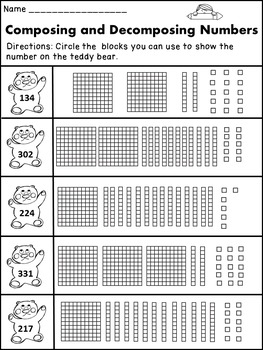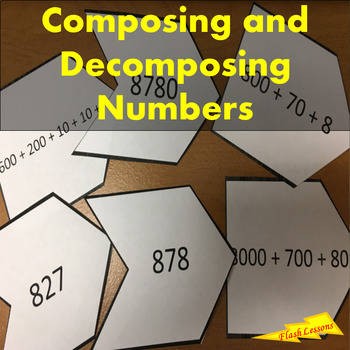

And trust me, the time it takes a child to do this is a lot less than the time it takes me to explain it! They can now solve it by decomposing the 5 into 2 and 3, adding the 2 to the 8 to make 10, and then adding the remaining 3 to get 13. They know that a combination for 5 is 2 and 3. Say the student is now presented larger numbers, like 8 + 5. This is actually the foundation for learning basic facts, but it goes beyond that. Consider the following examples:Ī Kindergarten student uses number bracelets to find all the combinations for a given number. Ĭomposing and decomposing numbers became part of our instructional vocabulary after the Common Core State Standards for Mathematics (CCSSM) were adopted in 2010. It’s a skill that starts in Kindergarten and follows students throughout their mathematical career, and it’s something that should be present in your classroom on a daily basis. One of the key factors in reaching that goal is helping our students learn to compose and decompose numbers. We call this making and breaking apart numbers. In this unit, students compose and decompose numbers to 10 in different ways. Think about the ultimate goal of math instruction-students with strong skills and flexibility with numbers. Unit 5 Composing and Decomposing Numbers to 10 Family Materials.

So what does that have to do with math you might ask. Every four years, I’m blown away by the strength and flexibility of these athletes.

Anybody else? I have to admit that I was not very flexible-I couldn’t do a smooth backward roll to save my life! That said, one of my favorite Olympic events is the gymnastics competition. They write an equation or number sentence and draw a picture.As a young girl, I briefly took gymnastics lessons. They decompose the number using cubes by breaking the cubes into 2 parts. Here are some activities for providing students meaningful opportunities to decompose numbers.
#Compose and decompose numbers to 10 how to#
Teach students how to use learning tools such a s part-part-whole, number bonds, and ten frames to model how to decompose numbers.Allow them to draw pictures, act it out using their whole bodies and fingers, and using objects. Allow students multiple opportunities and a variety of mediums to show their thinking.10 things in a scattered configuration given a number from 120, count out. Some new vocabulary words you want to use when modeling how to decompose is decomposing, joining and separating. Numbers and Operations in Base Ten Know number names and the count sequence. Invite students to share what they notice or what confuses them and use this time as an opportunity to clarify any misunderstandings. Teach them the language by modeling – show students how to decompose a number by modeling how to do it.Here are some strategies you can use to help your students The goal is to develop students’ understanding of numbers, such as learning that numbers are flexible. Students are expected to decompose numbers within 10, find the number that makes 10 and solve word problems by decomposing. Some students will be ready to write equations but when we first learn about decomposing, they use words to explain their thinking. They will decompose numbers drawing and using objects. Students are used to working with whole numbers (using objects to make 5) and will now learn that numbers can be broken into parts (2 and 3 are the same as 5). What’s Decomposing?ĭecomposing is breaking a number into parts. I love teaching decomposing! It’s a tricky concept, but there are TONS of activities you can use to teach this skill to primary learners. I have shared decomposing activities before.


 0 kommentar(er)
0 kommentar(er)
